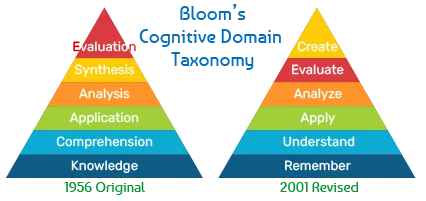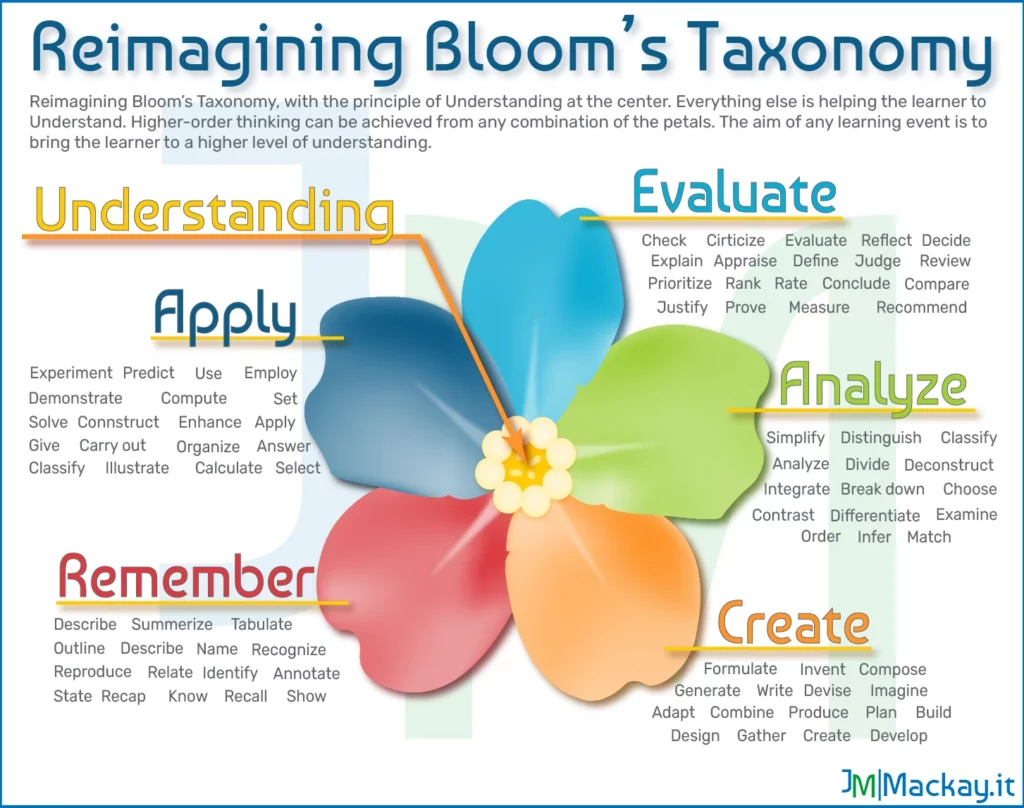Reimagining Blooms Cognitive Taxonomy (and Revised Version)
Bloom’s Taxonomy has been used within the education and training world for many years. The revised taxonomy made it easier to create meaningful learning objectives for courses. Many people will be familiar with the pyramid diagrams that propagate on the internet.
The origins of Bloom’s hierarchical Taxonomy date back to the mid-1950s. This was a time when great work was being produced by psychologists on the learning process. The taxonomy most people are familiar with is the cognitive domain. There are two other taxonomies that dealt with the “Affective” and “Psychomotor” domains.

Around 2001, one of Bloom’s students revised the Cognitive Domain Taxonomy. They began by applying verbs to the levels and then by adjusting the last two domains to place create at the top. This was done to make it more adaptive and accessible to today’s education systems.
What’s wrong with the way it was?
The revised version certainly made the original taxonomy more accessible. However, this didn’t address some of the more fundamental problems with the taxonomy. Ron Ritchhart of Harvard University’s Project Zero highlights the biggest flaws. In his book “Making Thinking Visible” he shows how Bloom’s hierarchical approach fails. Dr Ritchhart uses a simple example to show that we cannot assume “create” offers a higher level of thinking:
“A young child painting is working largely in application mode. Suddenly a surprise color appears on the paper, and she analyzes what just happened. What if she does it again but in a different place? She tries and evaluates the results as unpleasing. Continuing this back-and-forth of experimentation and reflection, she finishes her work of art. When her dad picks her up from school, she tells him about the new knowledge of painting she gained that day. In this way, there is a constant back and forth between ways of thinking that interact in a very dynamic way to produce learning.”
Unpacking Thinking in “Making Thinking Visible” (2011) R. Ritchhart et. al.
Dr Ritchhart shows that the sequential hierarchy of Bloom’s is not observed in real life. Learning occurs with a continual process of interaction with the various layers. He also observes the aim of the cognitive process is to develop understanding. So, if we place understanding at the center, should we look to rehome the verbs associated with this? Actually, the verbs associated with the “understanding” layer are already replicated elsewhere.
So, if we place understanding at the center, should we look to rehome the verbs associated with this? Actually, the verbs associated with the “understanding” layer are already replicated elsewhere.
Can we still use Bloom’s Taxonomy?
If we first remove the linear sequential hierarchy assumption. We should also remove the “Understand” layer. This should help give us much more freedom to bring about more meaningful learning.
Julie Dirksen in “Designing for How People Learn” suggests ignoring the in-built hierarchy. She shows we can still reach higher-order thinking and develop meaningful learning objectives. Instead of starting always at the Remember stage, we are now free to start at any suitable point we want to. We don’t always have to scale up through a combination of all the layers. By way of an example, Dirksen reverses the original order and shows how that can be an effective method too.
There is still clearly a place for some of the concepts included in Bloom’s Taxonomy. Considering the work of both Richhart and Dirksen, there is a need for a new diagram. The existing diagrams are preloaded with assumptions. Firstly, higher-order thinking is only attainable at the upper levels. Secondly, a set linear hierarchical sequence implies you must go from bottom to top in order.
How do I reimagine Bloom’s Taxonomy?
The simple idea of bringing learning back into Bloom. A flower with five petals. Understanding becomes the “pistil” of the flower. This is to remind us that all the effort is aimed towards improving understanding. As with a real flower, the petals are designed to help guide us into center, in our case that is understanding. Each petal is of equal size to disassociate any idea of hierarchy. I have then re-ordered the petals to remove any connection to the old approach. Evaluate, Analyze, Create, Remember, and Apply. The educator or instructor is then free to move around the petal in any order. A non-exhaustive list of verbs at each petal will help formulate learning objectives.

Bloom’s Reimagined aims to focus everything on improving understanding. This is achieved by applying the petals. The application of the petals will help to make learning sequences relevant to the topic. The application of the order of those petals is now no longer dictated. This means educators and instructors can use a sequence that is more meaningful to the topic.